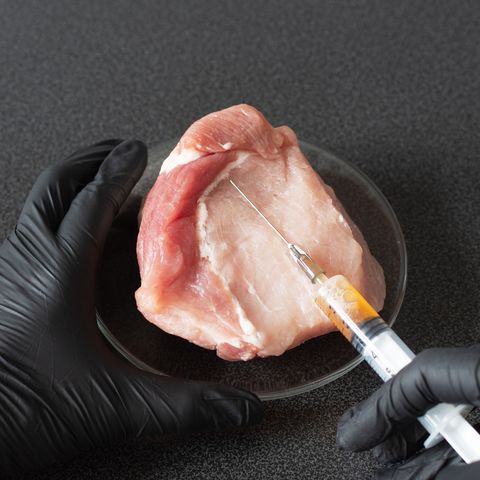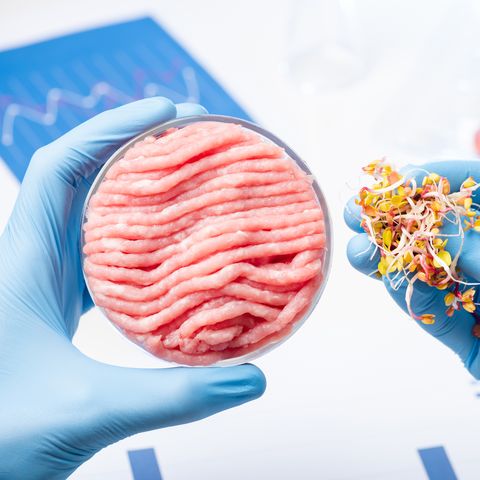Home » Diet & Food »
Calm Down Everyone, Impossible Pork Isn’t a Dietary Miracle
Impossible Foods, the Silicon Valley company that brought you the Impossible Burger (and, thus, the Impossible Whopper and Impossible Croissan’wich), is now pushing fake pork.
Impossible Pork made its debut this week at the tech expo CES in Las Vegas, and although at the time of publication there’s little information about the product on the company’s website, details of Impossible Pork have emerged through reports.
Like, the Impossible Burger, Impossible Pork appears marketed as an alternative to the meat it mimics. Reports are also touting the new fauxtein as healthier, championing Impossible’s fake pork as nutritionally superior to real pork.
To assess the ingredients and nutrition of Impossible Pork, we turned to someone outside Silicon Valley with an actual degree in nutrition: Abby Langer, R.D., founder of Abby Langer Nutrition and frequent caller-of-nutrition-bullshit on Twitter.
What’s In Impossible Pork?

Motortion
Again, the company has not yet published an ingredients list on its website, but reports list at least the following ingredients: soy, sunflower oil, coconut oil, “binders and flavorings,” and “heme,” shorthand for the delicious-sounding soy leghemoglobin, which has had a long and wild history with the FDA.
So what’s inside Impossible Pork is largely … soy.

Subscribe to Men’s Health
SHOP NOW
Like Impossible Beef, Impossible Pork a soy-based product with other ingredients tossed in to make it taste less like soy and more like meat.
Pork, by comparison, has one ingredient: pork.
“We’re looking at what I’d consider to be an ultra-processed food,” says Langer of Impossible Pork.
“That’s not saying that the Impossible product doesn’t have nutritional value or that it’s the same as eating a can of Pringles,” she says. “But it’s just reality: Fake meat is ultra-processed, meaning that it contains a lot of extra additives and ingredients to make it what it is.”
What Are the Nutrition Facts for Impossible Pork?

Inna Dodor
Reports state that a serving of Impossible Pork has 220 calories, 16 grams of protein, 1 gram of fiber (total grams of carbohydrates are not yet available), 13 grams of fat, and 0 milligrams of cholesterol.
By comparison the same amount 70/30 pork contains 350 calories, 17 grams of protein, 32 grams of fat, and 86 milligrams of cholesterol.
Pork, by nature, does not contain carbohydrates and so it also doesn’t contain fiber, which is a carbohydrate.
So Impossible Pork reportedly has less fat, marginally fewer calories, and marginally less protein than real pork.
But the cholesterol, you scream.

nevodka
Consider dietary cholesterol a zombie nutrition myth that just won’t die.
While studies from the 1980s found a link between eating cholesterol in foods and heightened levels of blood cholesterol, modern science has determined that there’s no direct causation between the two.
Harvard states this: “The biggest influence on blood cholesterol level is the mix of fats and carbohydrates in your diet—not the amount of cholesterol you eat from food.”
A 2018 review in Nutrients states this: “The current literature does not support the notion that dietary cholesterol increases the risk of heart disease in a healthy individuals.”
The claim that a no-cholesterol food is somehow healthier for you is an empty one.
And to the point of health…
Is Impossible Pork Healthier Than Pork?
“To me, comparing the nutrition in pork to the nutrition in Impossible Pork is besides the point,” says Langer. “Even though it’s ‘plant-based,’ don’t fool yourself into thinking that chowing down on some Impossible Pork is the same as eating a salad. The pork is one-ingredient and probably more satisfying.”

Claudia Totir
“That being said, vegans and the rest of us could always benefit from having another option for a plant-based protein source,” Langer says.
And as far as the health of fake meat products as a whole are concerned, consider what Ryan D. Andrews, R.D., a Connecticut plant-based-nutrition expert and author of A Guide to Plant Based Eating, told us.
“These kinds of meat analogs are recent inventions,” he says. “We don’t know the long-term health repercussions of regularly consuming them.”
The category of fauxteins is still too new to have a body of dietary intervention research reflecting a positive or negative effect on health.
“The average American is eating about seven ounces of meat per day. If this American were to do a straight swap and start eating seven ounces of meat analogs per day, with everything else in the diet being held constant, it’s hard to say for sure if this would offer much of a health benefit,” Andrews says.
So when it comes to eating Impossible Pork for your own personal health, consider following Langer’s lead: “Would I eat this product every day? No. Would I eat it as a protein option to mix things up? Definitely.”
Source: Read Full Article


